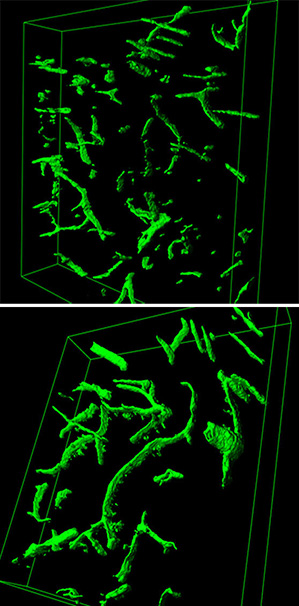Can Compounds in Young Blood Fix Aging?
Researchers and investors are already dreaming up ways to devise medical treatments based on the near-fantastical findings that the blood of young mice can rejuvenate older mice. In some cases, a single protein found circulating in the blood is sufficient to restore muscle tissue and improve brain activity.

The excitement is spurred by three newly published studies that showed that components of blood from young mice were able to repair damage and improve the function of the muscles and brains of older mice. Previous work from one of the research teams involved has also shown that a specific component of young blood can repair the damaged hearts of older mice.
“We started this work more than a decade ago, with a kind-of crazy hypothesis that there might be something in the blood that influences tissue repair with age,” says Amy Wagers, a researcher at the Harvard Stem Cell Institute, who is a coauthor on two of the three new works. (MIT Technology Review has covered Wagers’s work in the past, in “Young Blood Reverses Signs of Aging in Old Mice”; however, the study in question in that story was later retracted due to questions over the role of particular cells: “Research on Rejuvenating Effect of Young Blood Retracted.”) Last year, Wagers had reported that linking the circulatory systems of an older mouse and a younger mouse at the hip helped improve the appearance and function of the weakened, enlarged hearts of older mice. The team then screened the blood of young and old mice to look for differences and found that older mice had less of a protein growth factor called GDF11, which is also found in human blood.
Wagers and team then found that an injection of the protein into old mice had similar beneficial effects on the heart. In a new study published in the journal Science, Wagers and team show that it also has restorative effects on muscles in mice. In a second report, Wagers and her colleagues showed that the protein has restorative effects on the brains of older mice.
“The most exciting aspect of the set of papers is that there is a common signal talking to the brain, heart, and skeletal muscles,” says Wagers. “The same signal is talking to at least three organs and multiple cells types within each organ.”
A separate recent study from scientists at Stanford University showed that young blood changes older mice’s behavior and neural circuitry. The team saw improvements in learning and memory and a strengthening of connections between neurons in the hippocampus, a structure important to memory that deteriorates with age, even more so with diseases such as Alzheimer’s. The West Coast group, unlike the Harvard group, did not identify a specific protein responsible for the effects.
Based on Wagers’s new and previous results, the Boston-area venture capital firm Atlas Venture has started a still-unnamed company. Wagers’s previous findings caught the eye of the VC firm in 2013, and the new results “increased the excitement for the role of GDF11 in aging,” says partner Peter Barrett. “Now it’s the blocking and tackling of trying to understand what would be the best therapeutic approach to make this a commercial product.”
The company might target heart failure first, since Wagers’s team has shown that the growth factor can reverse age-related thickening of heart muscle in mice. In human patients, such thickening of the heart tissue can cause heart failure, and the condition currently has no treatment options, says Wagers.
GDF11 alone does not provide the full beneficial effects of young blood, says Wagers. “But now that we have a molecule that we can understand at a mechanistic level, we can start to build out the network of what is changing in the blood, find things that interact with GDF11, and regulate it to give us a clearer view of the network,” she says.
Though the results are exciting, there are many outstanding questions, including potential side effects. Other such growth factors, which encourage cell division, have been linked to cancer. Furthermore, blood vessel growth is a common feature of cancer development, and genes involved in stem cell function and regeneration have been linked to tumor growth. The Harvard-based studies on heart muscle, skeletal muscle, and brains were all conducted on the same mice, and the longest that the researchers studied the treated mice was 60 days. No ill effects were detected in those time frames, says Wagers.
One of the Stanford researchers, Tony Wyss-Coray, has cofounded a biotech company called Alkahest to test the therapeutic potential of his group’s findings.
Keep Reading
Most Popular
Large language models can do jaw-dropping things. But nobody knows exactly why.
And that's a problem. Figuring it out is one of the biggest scientific puzzles of our time and a crucial step towards controlling more powerful future models.
How scientists traced a mysterious covid case back to six toilets
When wastewater surveillance turns into a hunt for a single infected individual, the ethics get tricky.
The problem with plug-in hybrids? Their drivers.
Plug-in hybrids are often sold as a transition to EVs, but new data from Europe shows we’re still underestimating the emissions they produce.
Stay connected
Get the latest updates from
MIT Technology Review
Discover special offers, top stories, upcoming events, and more.